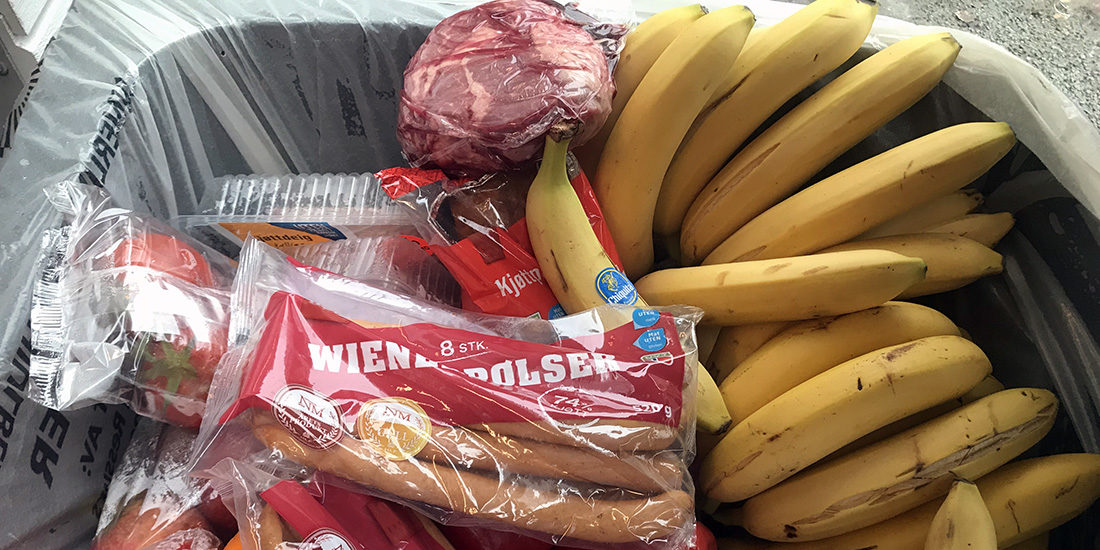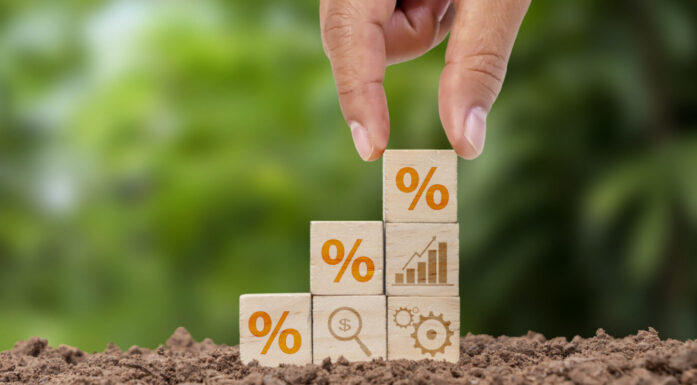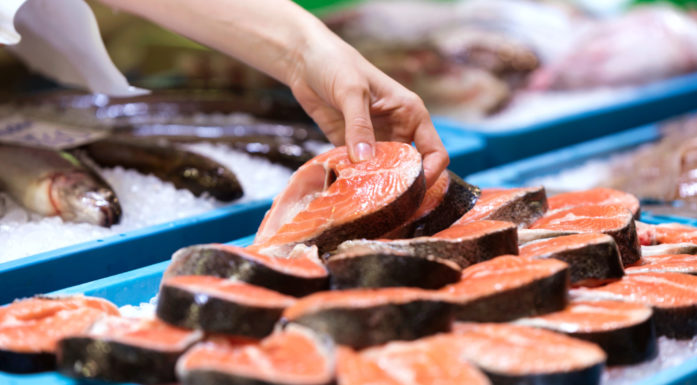How stores can throw out less food
Grocery stores throw out 75 000 tons of food annually. By adding date tagging to the barcode, food waste could be dramatically reduced, say two NTNU students.
According to the UN, one-third of the world’s food production goes to waste while ten per cent of humanity is starving. One of the UN’s sustainability goals is to halve the world’s food waste by 2030. The Norwegian government and the food industry have entered into an agreement to meet this goal.
When computer science students Hanna Sollie Storaker and Ingrid Vold set out to write their master’s thesis at NTNU, they wanted to explore whether digital solutions could reduce food waste in stores. Annual food waste in Norway comes to 355 000 tonnes, of which the grocery industry accounts for 75 000 tonnes.
“Every day, employees go through the store to pick out items that have expired. Cumbersome and labour intensive.”
The pressure to have full shelves and a large selection of goods makes it harder to sell everything before the expiration date.
Cumbersome
The students were surprised at what they learned about store routines.
“There was a surprising amount of manual work,” says Storaker.
“The stores had a lot of digital systems in place, but not for checking outdated products. The first stores we visited used manual date books. Every day, employees went through the store to pick out items that were out of date. That was a cumbersome and labour-intensive process.”
- You may also like: Eating your veggies, even in space
Good margin
Most food that is discarded has passed the “best before” date. Fresh meat, fish, seafood and others perishables are labelled with a “use-by” date. After that, the goods are not allowed to be sold or given away.
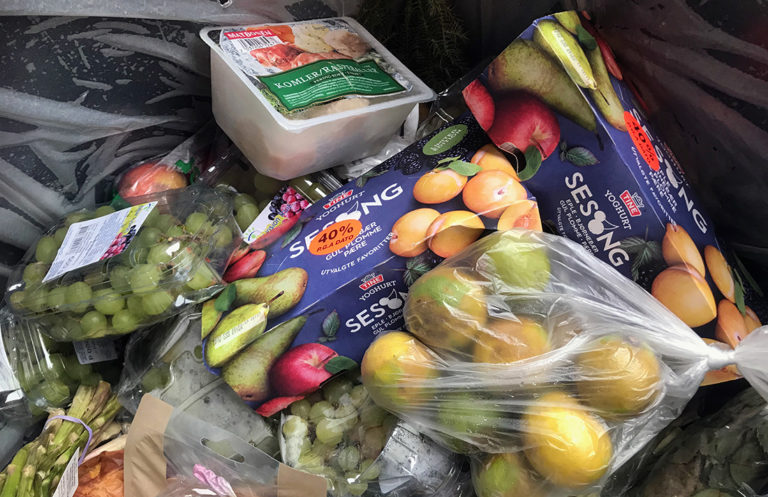
Food doesn’t have to be discarded when it passes the best-before date in Norway, but store owners find that customers are reluctant to buy this food. In this photo, food has been thrown out at a store in the Trondheim area. Photo: Idun Haugan
In determining date stamp labels, the manufacturer must take into account that some consumer groups may be particularly vulnerable to bad or spoiled food. Stores usually have a considerable amount of fruit and vegetable waste. A lot of bread tends to go to waste because people demand fresh bread.
Redistributing products
Many stores make arrangements with charities and food banks to accept products that are approaching expiration dates or have passed their best-before labelling date. In Trondheim, the students examined how this redistribution worked with agreements between the Rema grocery chain and the Church City Mission, and Food Banks Norway (Matsentralen) and several stores.
“Solution: Insert expiration date into the item’s barcode.”
According to the students’ survey, fewer than half of the area grocery stores are part of these arrangements. One problem for the receiving organizations is that they don’t know what they are going to be given, which makes it difficult to plan and use the items optimally.
Barcode with expiration date
Storaker and Vold proposing a simple solution to reduce waste: add the expiration date to the product’s barcode.
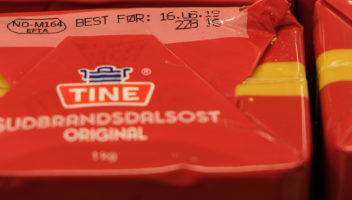
Including the expiration date or best-before date in the barcode would provide stores with a clear overview of goods approaching expiration. They can then be sold at a reduced price or given away. Photo: Svein Inge Meland
When the product information – including dating – is scanned on its way into the store, the employees can keep track of the expiration dates without doing a manual check, thus greatly simplifying the job. Products nearing expiration can be easily found and sold at reduced prices or given away.
The store can make it even easier and enter an automatic discount in the register for products approaching the expiration date.
Need different barcodes
The standard for barcodes in Norway is called the EAN-13 (European Article Number). It has lines and thirteen numbers. The code indicates the manufacturer and the specificity of the item – such as whether it is one litre of low fat milk or two litres of whole milk.
The barcode includes numbers in order to enter the code manually if the scanner can’t read the barcode.
The problem is that this type of barcode does not have the ability to include expiration date information. However, there are barcodes that do. Global Standards One (GS1) is a non-profit organization that maintains global standards for business communication, including barcodes capable of encoding expiration dates.
- You may also like: Solving the mystery of Serengeti’s vanishing wild dogs
The EU is introducing bar code labelling of drug packs with an expiration date and randomized serial numbers to reduce the risk of counterfeit medicines in the supply chain. The NTNU students believe that a similar standard should be introduced for foods.
Storaker says logistics pose the greatest hurdle to redistributing expiring products to charities and food banks.
“It’s difficult to put effective arrangements into place for picking up goods from stores and for storing them at charities. Refrigeration is a challenge and has to work reliably. Currently, these schemes depend on store managers prioritizing the extra work so that the cooperation between the stores and the recipients works well,” she says.
This collaboration may be easier in the cities than in more rural areas.
France and Italy have introduced laws against food waste. Storaker and Vold are happy that a similar law is also being considered in Norway.
The informatics candidates also suggest ways to simplify the collection of outgoing goods.
One method would be for robots to flit around the store and pick up the products from the shelves. They also imagine that drones may one day simplify transport to the food banks or charities.
Food waste law is coming
France and Italy have introduced laws against food waste. Storaker and Vold are pleased that lawmakers are considering similar legislation in Norway.
This kind of legislation “would force stores to do something,” says Vold. “I’m not sure whether it’s right to go as far as in France, which bans tossing unsold food. But a law against food waste should encourage developing digital solutions to reduce waste.”
Consumers are worse
The value of food waste from the food and grocery industries is NOK 6 billion annually. That’s indeed a huge amount, but it’s peanuts compared with what consumers throw out. Households discard nearly 220 000 tonnes annually, three times more than the grocery industry.
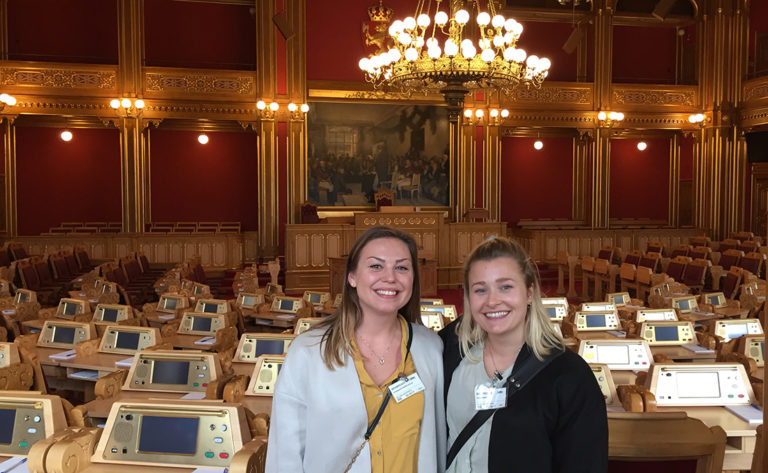
Hanna Sollie Storaker and Ingrid Vold interviewed politicians about a food waste law. Photo: Private
Storaker and Vold believe that date tagging in the barcode could also help reduce food waste at home.
A smart refrigerator with a scan function could read the product’s barcode. Then the fridge would warn that it’s time to make tacos to use up the ground meat that’s nearing its use-by date. If items had small RFID tags and the refrigerator had a reader, the information could be registered automatically. But for now, a tag on each item is too expensive and perhaps not very environmentally friendly.
Possible pilot project in 2019
“We’d like to see waste reduction happen faster,” says Terje Menkerud, senior advisor at GS1 Norway.
Menkerud hopes that the Norwegian grocery wholesaling group NorgesGruppen will start a pilot project this year to test out GS1 DataBar, a labelling system that has room for dynamic information like the production batch and date. The system requires replacing the software in store registers.
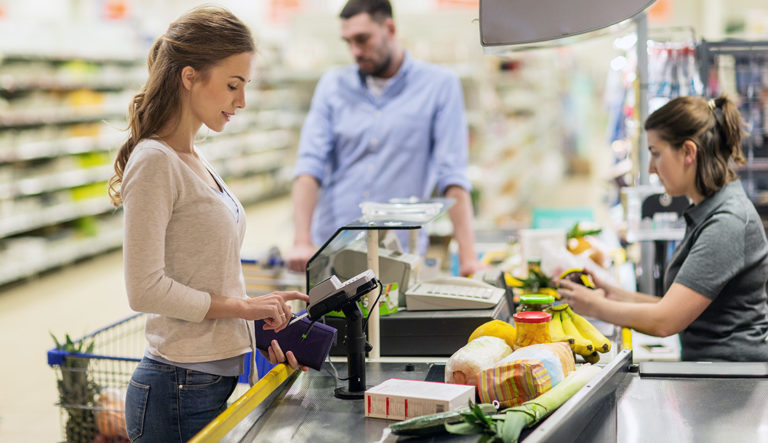
Dynamic labelling also enhances food safety. The register’s reader can prevent an item from being sold if the use-by date has passed. Illustration photo: Shutterstock
Several countries in Europe have similar pilot projects. Belgium is leading the way by introducing a new standard containing date information.
Safer food
Dynamic labelling also strengthens food safety, says Menkerud. The register’s reader can prevent the item from being sold if the use-by date has passed. Occasionally a production batch is recalled and has to be removed from the market. Then the software in the register can refuse to sell that particular item.
Discarding food is not just about wasting resources. It’s also poor environmental policy. According to Matvett AS, annual greenhouse gas emissions in Norway linked to food waste account for 380 000 tonnes of CO2 equivalents. Globally, the increased emissions account for 3.3 billion tonnes of CO2.
NTNU researcher Erica Löfström was the principal supervisor for Storaker’s and Vold’s master’s thesis.
